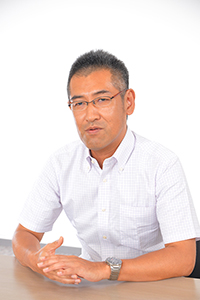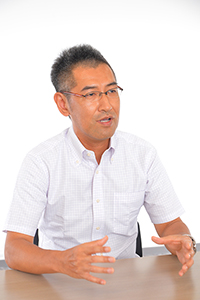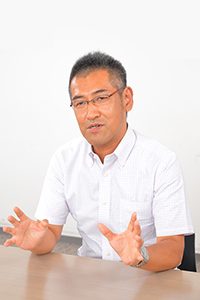- SOPHIA ONLINE Top
- Research at Sophia
- Yoshikazu Kikawada

Predicting Phreatic Explosions
- Yoshikazu Kikawada
- (Associate Professor, Department of Materials and Life Sciences, Faculty of Science and Technology, Sophia University)
Phreatic Explosions: Hard to Predict

Mt. Hakone is in the news today as people are concerned that a phreatic explosion may occur. The volcanic alert level for the Owakudani area was raised to level 2 at the beginning of May following a series of earthquake swarms on Mt. Hakone. I imagine that restricting entry is having a very negative impact given that it is a tourist area, but the situation still requires caution.
Since that time, there has been a number of reports of volcanic activity throughout Japan: rather large eruptions at Sakurajima and abnormalities around the Ogasawara Islands’ Nishinoshima which changed shape in 2013 after a series of volcanic eruptions. And, still fresh in the minds of the Japanese is the eruption of Mt.Kiso Ontake last year which was the nation’s worst volcano disaster since World War II. It can indeed be said that there has been an increase in news in Japan on volcanoes recently. Some say that the tectonic deformations caused over a vast area by the massive earthquake on March 11, 2011, are triggering the increase in volcanic activity in various regions. I, too, think that this view cannot be dismissed although there is no solid scientific proof behind it.
The various phenomena, however, are not connected to each other, so they cannot be classed together as a single group for discussion. As you may know, it is hot magma deep underground that triggers volcanic activity. This is true of all volcanic activity, but each volcano varies in structure and geological background so volcanos behave completely differently one to the next.
Let’s turn again to the situation on Mt. Hakone today. It is phreatic explosions or phreatic eruptions that people are concerned may happen in the Owakudani area. A phreatic explosion is not an eruption where lava from the magma itself break through the earth’s surface. A phreatic explosion is an eruption that happens when pressure builds up, as heat from the magma causes groundwater to turn into hot steam and burst through the earth’s surface.
Data from seismographs and tectonic deformation data captured by tiltmeters and Global Navigation Satellite Systems (GNSS) are generally used to observe volcanic activity and predict or forecast eruptions. However, only when there has been a large movement in magma do changes that would directly result in the prediction of a volcanic eruption appear in these kinds of data.
Phreatic explosions do not necessarily involve movements in magma so it is hard to predict such explosions from seismic and tectonic deformation data. The 2014 Mt. Kiso Ontake eruption was a phreatic explosion, and that is why no one was able to predict it.
It is thought that the earthquake swarms and uplifts observed in Hakone these days are not due to movements in magma but are caused by increases in pressure from volcanic gases and steam in places close to the earth’s surface. This has not resulted in a sudden phreatic explosion as at Mt. Kiso Ontake, but considerable pressure has already built up. Is there no way to predict phreatic explosions?
Chemical Volcanology : Effective in Predicting Phreatic Explosions

In addition to the approach I just described that is used to understand earthquakes and tectonic deformations, there is another approach applied in volcano research that is considered effective for predicting phreatic explosions. That approach is chemical volcanology, and it is my field of research.
Magma releases various volatile substances. These substances are emitted as volcanic gases from fumaroles in volcanic regions, and they also enter the groundwater and are then discharged in hot spring water.
Chemical volcanologists take samples of these gases and liquids and chemically analyze their composition. If it is confirmed that there has been a change in the analytical results of samples taken periodically at the same volcano, it means that there has been some kind of change in the underground environment. Although not shown on a seismograph or other device, the changes may correspond to alterations in the temperature distribution underground or in the percentage of volcanic gases and groundwater?both of which are related to phreatic explosions.
To use the analogy of medicine, using seismographs and GNSS is like making a diagnosis using x-rays and echography, and chemical volcanology is like making a diagnosis based on blood and urine tests. One is not better than the other. As you can well imagine, you can make a more accurate diagnosis by skillfully using the tools in combination.
At the time of the creation of the Faculty of Science and Technology at Sophia University in 1961, the laboratory that handles chemical volcanology (geochemistry) was started by Professor Eiichi Minami who was an authority in the field at that time. The laboratory has been restructured and split over the years. The chemical volcanology laboratory that I head now has been conducting chemical observations and research on Mt. Kusatsu-Shirane for over 50 years, and the lab contributed greatly to the prediction of the phreatic explosions on that mountain from 1976 to 1983.
As has been reported in the news, scientists are conducting volcanic gas surveys on Mt. Hakone, and they should have a wealth of past data, as well. Mt. Hakone has not erupted in a long time, but there have been several earthquake swarms recently. I am sure the scientists are comparing the data from those swarms and studying the situation comprehensively by considering it in conjunction with earthquake and tectonic deformation observations.
Unfortunately, it is rare that this can be done. There are almost no scientists in the field of chemical volcanology in Japan. This means, as a result, that there are almost no mountains where chemical volcanology studies are performed on an ongoing basis.
Intentionally Investing in Unglamorous but Important Research

Why do the chemistry fields of volcano research lag behind? The main reason is because the research requires a lot of labor.
If you set up seismographs, tiltmeters, and GNSS receivers, you can continuously collect observation data on earthquakes and tectonic deformations without having to invest any labor. It is very difficult, on the other hand, to automate the collection and analysis of samples of the substances that are the basis of chemical observation, particularly, volcanic gases that mix upon release with the atmosphere. The scientist must climb the mountain him or herself, approach the crater which is dangerous to do at times, and take the samples of volcanic gas or crater lake water.
In addition, the results of volcano research can be confirmed only after an eruption has taken place and it is clear whether the science was successful in predicting the eruption and limiting damage. In other words, there is no way to tell whether the research is helpful or not unless there is an eruption. Not only are there are few people who want to do that kind of research, but it is hard to get the budget for the work in the first place.
If you start the research after there has been an eruption, however, it may not be very helpful in predicting the next eruption. If you do not bring together data from normal times, data from immediately before the eruption, and data from after the eruption, the research is meaningless. In other words, like our research on Mt. Kusatsu-Shirane, it is precisely because data is collected on an ongoing basis that it produces helpful results at the time they are needed the most.
As mentioned earlier, each volcano is unique. One difficulty in volcano research is that data cannot be applied broadly in most cases and each mountain must be studied individually. However, it is known to some degree which mountains have a high probability of having phreatic explosions, and we are accelerating countermeasures for such mountains. As a scientist, I am ashamed that we were not able to take chemical observational data on Mt. Kiso Ontake.
It seems that chemical volcanology is not very well funded overseas, either. Japan, a nation with many volcanoes, does not have a national research institute that oversees in a centralized fashion comprehensive volcano research, surveys, and monitoring. This is inadequate not only from the perspective of science but also from the perspective of disaster prevention.
I hope that there will be more and more investment in research, like chemical volcanology, that does not produce glamorous results and particularly in developing scientists who can spearhead the field.
The inside of the earth may be right under our feet, but it is an unknown world that is hard to see with the naked eye just like outer space or perhaps even more so than outer space in this day and age where technology capable of exploring outer space has been developed. It is indeed the unique joy of a scientist to be able to see from the data that you yourself collected in the field some part of the mystery of what is inside the earth and what is going on there. Moreover, your discovery may save many lives in the future.
I truly hope that more and more young scientists take up chemical volcanology and the framework for training them is enhanced.

- Yoshikazu Kikawada
- Associate Professor, Department of Materials and Life Sciences, Faculty of Science and Technology, Sophia University
Mr. Kikawada’s specialties are volcano chemistry and environmental analytical chemistry. He is an expert member of the Liaison Committee of the Mt. Kusatsu-Shirane Volcanic Disaster Management Council. His motto is “Don’t get lost in empty theories; the truth is in the field.” His publications include Onsen kagaku no saizensen (The latest developments in hot spring sciences ; coauthored; Kyoto: Nakanishiya, 2004).





